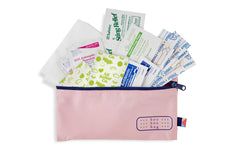Any pet parent knows that traveling with your dog is no easy feat. You must take the proper precautions to make sure your pup is safe and as comfortable as possible for the trip. While it does take some extra planning and effort to bring your furry baby along, it can make the trip that much enjoyable as you reconnect with family in another state, explore a different city, or venture into a new natural landscape.
There’s plenty of pet-friendly possibilities while you’re traveling, you just have to put in a little research time. You don’t have to miss your pet while you go on your next adventure, just make sure you follow these steps to make the trip enjoyable for you both.
What To Bring - Supplies
Food/Water/Medicine
First, you want to make sure your pup is in good shape to travel. Make a trip to the veterinarian and get a checkup before you hit the road. You should also look up the nearest 24-hour veterinary clinic at your destination so you’ll be prepared in the event of an emergency. All shots should be up to date, and it’s not a bad idea to take shot records with you. Make sure that you bring along his or her regular food, treats, and plenty of bottled water. Don’t forget any medication they need as well.
Crates/Toys
Crates are essential for any form of traveling, and is a requirement for airline travel. When you get to your final destination, it’s a great way of keeping your dogs from getting into trouble wherever you’re lodging, and it also keeps them safe while in the car. Your crate should have plenty of ventilation, be large enough for your pup to stand, turn and lie down, and have a leak-proof bottom that’s covered with absorbent material. If you’re flying, include a “Live Animal” label with arrows indicating the upright position (your airline may have specific size requirements as well). It should also have your name, address and phone number on it. For your dog’s comfort, don’t forget to include their favorite toys (for inside the crate and later outside of the crate), water bottle and a comfy mat to lay on.
Identification
You’ll want to make sure you have the proper identification for your beloved pup just in case you get separated. Even if your dog has a microchip, you’ll want to make sure he has a sturdy leash and collar. On the collar, make sure you have included your dog’s name, your name, and your contact information. It should also have proof of their rabies shots as well. If you haven’t gotten a permanent form of identification like a microchip for your dog, now is a good time to consider this option.
 A Bag for the Essentials
A Bag for the Essentials
It’s best to have easy access to the essentials, and something like a Kibou bag is the perfect accessory to bring along on a trip. A leash, paw wipes, treats, and poop bags will easily fit along with your keys, IDs and phone in a comfortable and stylish bag that can be worn as a crossover or as a belt bag. Perfect for if you need to pop out for a potty break, or for walking through the airport.

Flying With Your Dog
While you’re at the vet checkup prior to your trip, be sure to get a certification of health which is required when flying by air and must be provided to the airlines no more than 10 days before travel. Your pup’s rabies and vaccination certificates are also required. They’ll also be checking that your dog is over eight weeks old and has been weaned.
Each airline has its own regulations and services when it comes to traveling with your pet, so it is good to check with them before you purchase your tickets (check out this guide for pet policies of all U.S. airlines). When you’re making your reservation, you also have to make one for your dog as they have a limited number of animals that are allowed on each flight.
There are also federal regulations for the dogs’ safety that prohibits shipping live animals in excess baggage or cargo if they will be exposed to temperatures below 45 degrees fahrenheit or above 85 degrees fahrenheit for more than four hours. Much of this is dependent on where you are traveling. In any case – traveling in cargo can be a stressful experience for your pup so it is best to consult with your veterinarian for your dog’s individual needs.
If you think your dog would be better off, ask your veterinarian about whether she should be tranquilized for the trip.
For Road Trips
If your dog isn’t used to riding in the car, start taking more short practice trips to get them used to it. You’ll want to consider a dog seat belt or a dog car seat to keep your dog safe, and you should never let your pup ride in the back of an open truck because it is extremely dangerous. Also, it goes without saying that you should never leave your dog unattended in a closed vehicle – particularly in the summer months when they can suffer from heat stroke/exhaustion. In any season, it is best to leave a family member with the dog in the vehicle.
Bring along plenty of water to keep your dog hydrated, and plan for a lot of potty breaks. It’s best to let your dog travel on an empty stomach to avoid car sickness. Keep feedings light until you are stopped for the day. Also, if you’re traveling together with children and your dog, be sure to remind your kids not to overwhelm the dog in the car as they too will be bored and more irritable.
Taking the Bus, Train or a Cruise
As it comes to traveling by bus, the rules vary city-by-city, so it’s important to check where you’ll be traveling. Major bus lines like Greyhound do not allow dogs at all, with the exception of service dogs. Amtrak trains will allow dogs to come along with you so long as they are under 20 pounds and remain in their carrier (for an extra fee).
Planning to go on a cruise? This too is dependent upon your cruise line. Be sure to check with them before you book anything. 
When You Get There - Lodging
You’ll want to carefully plan where you stay at your final destination, and plan for any stops you may take overnight while on the way. Many hotels do not allow pets, so you’ll want to do your research beforehand to prevent being too tired to drive and unable to find a place to rest.
If you do find lodging that permits pets, be sure to be considerate to the other lodgers and to the staff and management. Pick up after your dog, and do not leave your dog unattended where they will bark continuously or even destroy property.
If you’ve followed all of these steps, you should be prepared to travel with your dog. We hope you have a wonderful trip with your furry friend!




Leave a comment